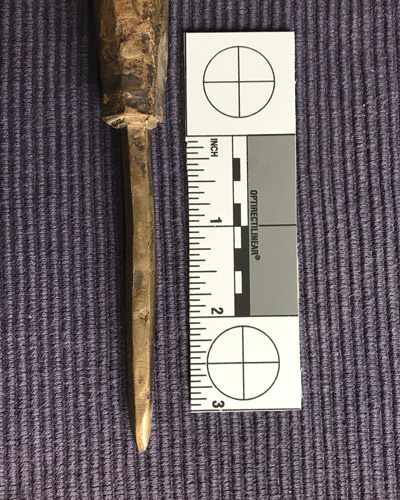Professor Anagnostis Agelarakis, Ph.D., is widely renowned for his archaeological work in Greece, as well as here at Adelphi, for bringing his students with him to gain hands-on experience with the summer Field Research program in Greece.
 Professor Anagnostis Agelarakis, Ph.D., is widely renowned for his archaeological work in Greece, as well as here at Adelphi, for bringing his students with him to gain hands-on experience with the summer Field Research program in Greece. While carrying out archeological research at the necropolis of ancient Thasos in the summer of 2002, Dr. Agelarakis, Argiro Agelarakis, adjunct professor of anthropology, and Adelphi students recovered the remains of 57 individuals who had lived on the island 2,000 years ago, including those of one man, buried alone, with a very identifying feature.
Professor Anagnostis Agelarakis, Ph.D., is widely renowned for his archaeological work in Greece, as well as here at Adelphi, for bringing his students with him to gain hands-on experience with the summer Field Research program in Greece. While carrying out archeological research at the necropolis of ancient Thasos in the summer of 2002, Dr. Agelarakis, Argiro Agelarakis, adjunct professor of anthropology, and Adelphi students recovered the remains of 57 individuals who had lived on the island 2,000 years ago, including those of one man, buried alone, with a very identifying feature.
There was a perfect hole in his chest.
Further studies of the man found him to be robustly built, suggesting a life of physical activity. There appeared to be, during a brief period before his death, a noticeable change in the quality of food he’d eaten. He died in his sixth decade when a sharp weapon tip pierced his sternum.
 To understand more, students and faculty in Adelphi’s departments of anthropology, art and physics—including David Hornung, professor of art and art history; Sean Bentley, Ph.D., associate professor of physics; and Argiro Agelarakis—collaborated to first create a bronze casting of the weapon: a styrax, the pointed end of a thrusting spear. They then conducted forensic archaeometry tests measuring the force, speed and momentum of the weapon’s strike.
To understand more, students and faculty in Adelphi’s departments of anthropology, art and physics—including David Hornung, professor of art and art history; Sean Bentley, Ph.D., associate professor of physics; and Argiro Agelarakis—collaborated to first create a bronze casting of the weapon: a styrax, the pointed end of a thrusting spear. They then conducted forensic archaeometry tests measuring the force, speed and momentum of the weapon’s strike.
The studies suggested he was physically restricted to receive a single, death-causing blow that caused cardiac shock and arrest, killing him in only one minute.“The trauma points to a well-calculated thrusting strike by an experienced hand at a precise anatomic point known that it could and would provide for a fast and irrefutable way to kill,” Dr. Agelarakis observed, adding that the remains and burial location suggest not a criminal executed for a crime, but a “worthy opponent” who met his “untimely and violent death” as a result of political-military turmoil.
These important observations and archaeological and historical contexts are presented in the article “Execution by Styrax in Ancient Thasos” published by Access Archaeology.
The resulting research paper, “Executed by Styrax in Ancient Thasos,” was published by Archaeopress Archaeology, based in Oxford, England. In addition, more than 50 news outlets in the United States and abroad—including Live Science, Forbes, Newsweek, Archaeology Magazine, the Daily Mail and FOX News—have reported on this fascinating story that offers insight into life—and death—in an ancient civilization.
For further information, please contact:
Todd Wilson
Strategic Communications Director
p – 516.237.8634
e – twilson@adelphi.edu